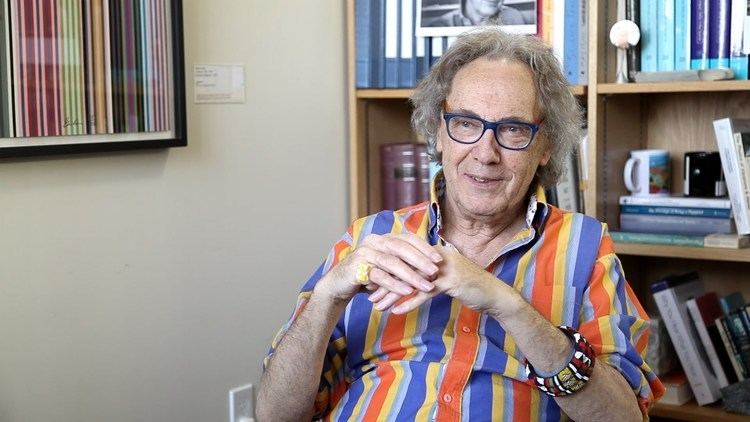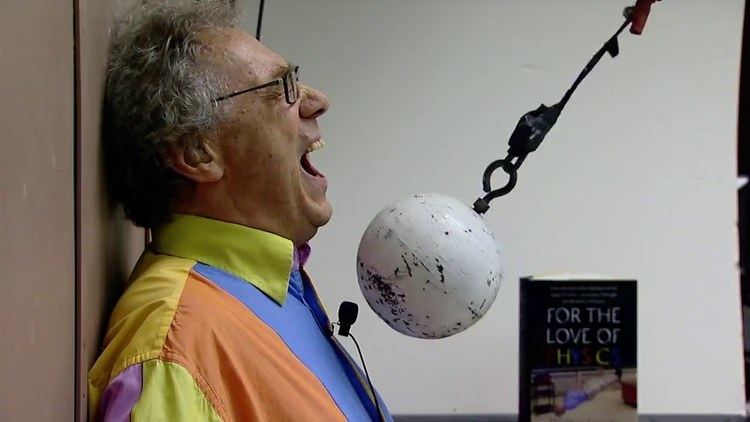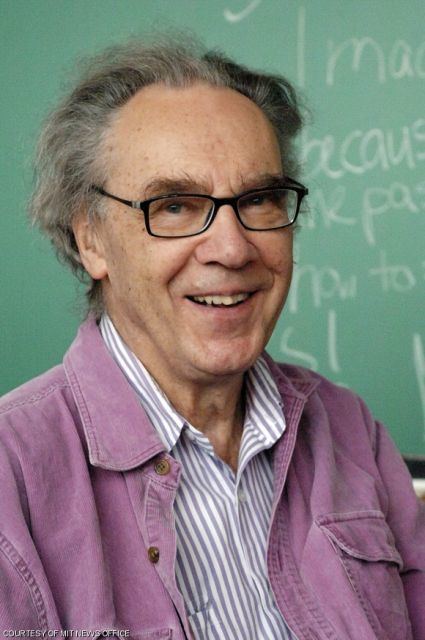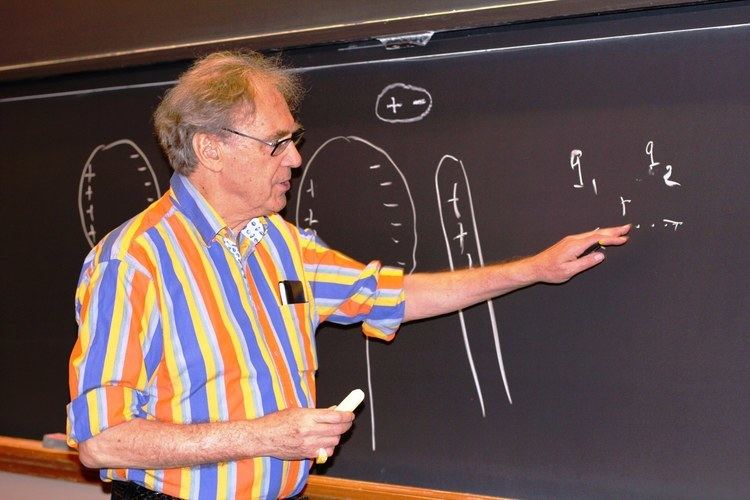Nationality Dutch Role Professor | Name Walter Lewin Institutions MIT | |
 | ||
Residence Netherlands,United States Notable awards NASA Award for Exceptional Scientific Achievement (1978)Alexander von Humboldt Award (1984 and 1991)Guggenheim Fellowship (1984)MIT Science Council Prize for Excellence in Undergraduate Teaching (1984)W. Buechner Teaching Prize (1988)Everett Moore Baker Memorial Award for Excellence in Undergraduate Teaching (2003) Books For the Love of Physics: From the End of the Rainbow to the Edge Of Time - A Journey Through the Wonders of Physics Parents Walter Simon Lewin, Pieternella Johanna van der Tang Awards Guggenheim Fellowship for Natural Sciences, US & Canada | ||
Interview with MIT Physics Professor Walter Lewin
Walter Hendrik Gustav Lewin (born January 29, 1936) is a Dutch astrophysicist and former professor of physics at the Massachusetts Institute of Technology. Lewin earned his doctorate in nuclear physics in 1965 at the Delft University of Technology and was a member of MIT's physics faculty for 43 years beginning in 1966 until his retirement in 2009.
Contents
- Interview with MIT Physics Professor Walter Lewin
- For the love of physics walter lewin s last lecture
- Early life and education
- Academic career
- Awards
- Lectures
- Personal life
- TV performances
- Books
- Selected publications
- References

Lewin's contributions in astrophysics include the first discovery of a rotating neutron star through all-sky balloon surveys and research in X-ray detection in investigations through satellites and observatories.

Lewin has received awards for teaching and is known for his lectures on physics and their publication online via YouTube, edX and MIT OpenCourseWare.

In December 2014, MIT revoked Lewin's Professor Emeritus title after an MIT investigation determined that Lewin had violated university policy by sexually harassing an online student in an online MITx course he taught in fall 2013.

For the love of physics walter lewin s last lecture
Early life and education
Lewin was born to Walter Simon Lewin and Pieternella Johanna van der Tang in 1936 in The Hague, Netherlands. He was a child when Nazi Germany occupied The Netherlands during World War II. His paternal grandparents Gustav and Emma Lewin, who were Jewish, were gassed in Auschwitz in 1942. To protect the family, Lewin's father simply left one day without telling anyone, leaving his mother to raise the children.
Academic career
Lewin went to Massachusetts Institute of Technology in January 1966 as a post-doctoral associate, and was appointed an Assistant Professor. He was promoted to Associate Professor of Physics in 1968 and to full Professor in 1974.
At MIT, Lewin joined the X-ray astronomy group and conducted all-sky balloon surveys with George W. Clark. Through the late seventies, there were about twenty successful balloon flights. These balloon surveys led to the discovery of five new X-ray sources, whose spectra were very different from the X-ray sources discovered during rocket observations. The X-ray flux of these sources were variable. Among them was GX 1+4 whose X-ray flux appeared to be periodic with a period of about 2.4 minutes. This was the first discovery of a slowly rotating neutron star.
In October 1967 when Scorpius X-1 was observed, an X-ray flare was detected. The flux went up by a factor of about 4 in ten minutes after which it declined again. This was the first detection of X-ray variability observed during the observations. The rockets used by other researchers could not have discovered that the X-ray sources varied on such short time scales because they were only up for several minutes, whereas the balloons could be in the air for many hours.
Lewin was co-investigator on the Small Astronomy Satellite 3 (SAS-3) project. He directed the burst observations and discovered several X-ray bursters, among them was the Rapid Burster which can produce thousands of X-ray bursts in one day. His group also discovered that the Rapid Burster produces two types of bursts and established a classification of bursts as type I (thermonuclear flashes) and type II (accretion flow instabilities).
Lewin was Co-Principal Investigator on High Energy Astronomy Observatory 1 HEAO-1 (A4), which has yielded the first all sky catalog at high-energy X rays. With H. Pedersen and J. van Paradijs, Lewin made extensive studies of optical bursts which are associated with X-ray bursts; for X-ray detections they used SAS-3 and the Japanese Observatory "Hakucho". Their combined burst observations demonstrated that the optical bursts are a few seconds delayed relative to the X-ray bursts. This established the size of the accretion disc surrounding the accreting neutron stars.
In his search for millisecond X-ray pulsations from low-mass X-ray binaries, in 1984–85 Lewin made guest observations with the European Observatory EXOSAT in collaboration with colleagues from Amsterdam and Garching, Germany. This led to the unexpected discovery of intensity-dependent Quasi-periodic oscillations (QPO) in the X-ray flux of GX 5-1. During 1989 to 1992, using the Japanese Observatory "Ginga", Lewin and his co-workers studied the relation between the X-ray spectral state and the radio brightness of several bright low-mass X-ray binaries.
Lewin was closely involved in ROSAT observations of the nearby galaxies M31 and Messier 81. Lewin and his graduate student Eugene Magnier have made deep optical charge-coupled device observations of M31 in four colors; they have published a catalogue of 500,000 objects. Lewin and his graduate student David Pooley initiated the successful X-ray observations within six days of the appearance of supernova SN 1993J in M81.
Lewin collaborated with his close friend Jan van Paradijs of the University of Amsterdam from 1978 until van Paradijs' death. They co-authored 150 papers.
He became a corresponding member of the Royal Netherlands Academy of Arts and Sciences in 1993 and a fellow of the American Physical Society in 1993.
Lewin and graduate student Jeffrey Kommers have worked on data from the Compton Gamma Ray Observatory (GRO). This was a collaboration with the BATSE Group in Huntsville, AL. In early December 1995, with co-workers Chryssa Kouveliotou and Van Paradijs, they discovered a new type of X-ray burst source: (GRO J1744-28) the Bursting Pulsar, and received a NASA Achievement Award for this discovery.
In 1996–1998, Lewin's collaboration with Michiel van der Klis in Amsterdam led to the discovery of kHz oscillations in many X-ray binaries.
Using the Chandra X-ray Observatory, Lewin and his graduate student David Pooley made extensive studies of supernovae and faint X-ray sources in globular clusters. This research was done in collaboration with scientists from the University of Washington, IAS in Princeton, UC Berkeley, the University of Amsterdam and Utrecht in The Netherlands, and the Naval Research Laboratory in Washington, DC. The research on supernovae produced the first X-ray spectrum with unprecedented energy resolution of SN 1989S. The research on Globular Clusters demonstrated that X-ray binary stars are cooked in the cores of the clusters where the stellar density is very high.
With graduate student Jon Miller, Lewin made extensive studies of black-hole X-ray binaries in our galaxy. Evidence was found for spectral distortions of the iron line (in X-rays) indicative of the influence of general relativity on the iron-line emission in the vicinity of the "event horizon" of the black holes. This research on black-hole binaries is continuing using all available observatories in orbit - among them: Chandra, the Rossi X-ray Timing Explorer (RXTE), and the European observatories XMM-Newton, Integral and NuSTAR.
Lewin has published about 450 scientific articles as of 2014.
Awards
On April 3, 2012, Lewin was ranked by the Princeton Review among "The Best 300". He was the only MIT faculty member (albeit, retired) to make it to that list.
Lectures
For about 15 years (starting in 1982) Lewin was on MIT Cable TV, with every week a different 1-hour program. They were aired 24 hours per day helping freshmen with their weekly homework assignments (they were called "Help Sessions"). Walter Lewin's 1992 lectures on Newtonian Mechanics (co-lectured with Bob Ledoux) and Lewin's "Help Sessions" have been shown for over six years (starting in 1995) on UWTV in Seattle, WA, reaching an audience of about four million people. Years later, Bill Gates wrote Lewin that he watched him very frequently on UWTV. Lewin personally responded to thousands of e-mail requests that he received per year from UWTV viewers. Videos of Lewin's 94 lectures on Newtonian Mechanics (1999), Electricity and Magnetism (2002) and the Physics of Vibrations and Waves (2004), among others, could be viewed on the MIT OpenCourseWare web site until MIT removed them after finding that Lewin had sexually harassed a student in the online course. The videos can also be viewed on YouTube, iTunes and Earth Academic.
Two of Lewin's lectures have been viewed over a million times on YouTube. His 2011 farewell lecture "For the Love of Physics" is presently (May 2015) being viewed about 5000 times daily. Many of his lectures can be viewed online on his personal YouTube channel. In 2007, The New York Times featured Lewin on the front page, talking about his massive influence on online education.
Two of Lewin's courses were converted into edX courses, 8.01x (classical mechanics) and 8.02x (electricity and magnetism). People who pass "x" courses receive a certificate from MIT. Lewin's course on Electricity and Magnetism went online in February 2013, Newtonian Mechanics is online as of September 2013. As of May 2014, there were yet no plans to convert 8.03 "Vibrations and Waves" into an edX course.
Videos of Lewin’s lectures on Videos on Teaching Excellence at MIT, YouTube and iTunes U have been viewed more than 12 million times by people all over the world — including Bill Gates, who has confessed to repeated viewings.
In the summer of 2012, Lewin returned from his retirement to deliver a lecture series initiated and funded by the Japanese Broadcasting Corporation (NHK). Each lecture features a selection of physics demonstrations that Lewin has used in his more than 43 years of teaching Physics at MIT. The lectures consist of 8 TV programs that were broadcast in Japanese on NHK in Japan in 2013. As of 2015, a region 2 DVD box set of this series is available in Japanese, with an optional partial English audio track and English subtitles.
In early December, 2014, MIT announced that it had determined that Lewin engaged in online sexual harassment of an online MITx learner in violation of MIT's policies. Inside Higher Ed reported that this learner was one of many (at least 10) female students to whom Lewin had sent inappropriate messages. The alleged victim, who said that she was a 32-year-old woman living in France and that she came forward to ensure the case is not forgotten, asserted that Lewin pushed her to participate in sexual role-playing. As a consequence of its internal investigation, MIT revoked Lewin's professor emeritus title and indefinitely removed his lectures from the institute's online learning platforms. However, Lewin's lectures are readily available on several websites. As of April 2015, his course lectures average approximately 5000 views a day.
Personal life
Lewin is an art enthusiast and collector. He has lectured on the subject at MIT. In the 1970s and 1980s, he collaborated with the artists Otto Piene (born in Germany), who was one of the founders of the ZERO movement and the director of MIT's Center for Advanced Visual Studies, and Peter Struycken (Dutch), who is a computer artist.
TV performances
Below are a selection of notable TV appearances:
Books
Selected publications
Lewin has published about 450 scientific articles, below are a selected few.
